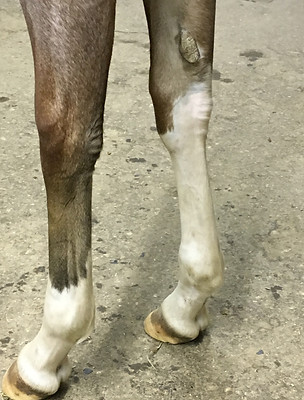
MINNESOTA HORSE WELFARE COALITION
Keeping horses safe at home
Expert support from the Animal Humane Society is available to citizens and law enforcement personnel who are concerned about the welfare of a horse.
Our role is to advocate for the horse and the horse owner and help identify conditions and circumstances where a horse may be vulnerable and need assistance.
Here is a quick reference guide with some tips on what to look for when observing or assessing a horse who may need help.

A healthy hoof
Naturally smooth hoof wall
Smooth, uniform shape free from cracks, rings, flares, etc.
Small cracks can be normal
Extreme cracking or hooves that curl up are severely neglected.
A healthy hoof

Legs and feet
The horse should stand squarely with weight evenly distributed.
Slightly raising and taking the weight off a hind leg is normal, but not for a foreleg.
Legs should be free of bumps, swelling, cuts or hair loss.
Healthy legs and feet

Hair coat
A shiny, glowing coat is a sign of good health that comes from meeting the horse's nutritional requirements
A dull coat can be a sign of poor nutrition, parasites or general poor health.
A thick, long coat that does not shed out in summer can be a sign of Cushings and needs vet care.
Healthy hair coat

Condition scoring
The Henneke horse body condition scoring system is a numerical scale. Scores range from 1 (poor) to 9 (extremely fat), The ideal range for horses is from 4-6. The system is used by law enforcement agencies as an objective method of scoring a horse's body condition in horse cruelty cases.
A healthy body condition

Eyes and noses
Eyes should be clear, fully open and clean, not cloudy or discolored.
Eyes should not have unusual discharge or a dull glazed appearance..
The nostrils should be clean and free of excessive mucus. However, it is normal to have a trickle of clear liquid from the nostrils.
Healthy eyes and nose

Hydration
The average horse drinks between five and 10 gallons of water a day, depending on exercise level and weather conditions.
Horses need fresh, clean water that is not too hot or too cold.
Horses do not eat snow to meet hydration needs.
Healthy hydration

Attitude
Healthy horses are bright and alert, and interested in other horses, you and their surroundings. They will roll occasionally, especially after being turned out, but always shake the dust off after rolling.
A horse that rolls over and over and often looks at its side might be experiencing signs of colic.
A healthy attitude

Shelter
Horses can adapt to a variety of weather conditions if allowed to acclimate to the climate and have adequate feed and water.
Horses should have free access to shelter for shade and protection from wet, windy or harsh conditions.
Access to shelter

Forage
Horses eat about 2% of their body weight in forage (grass or hay) per day. An average 1,000 lb. horse needs 20 pounds of hay per day.
Estimate the supply by weighing and counting the bales to see how many days of forage is on hand.
For pastures, the average height of grass should be 4" or higher.
Sufficient forage (grass or hay)

Companionship
Horses naturally live in herds and a normal horse is never alone by choice.
Horses feel safer when they have other horses around them.They take turns to watch over each other while they sleep.
Horses carry out social activities such as mutual grooming and playing.
Companionship

Fencing
A safe horse fence is strong, highly visible, durable, and free of hazards.
\If a horse does run into the fence, the fence should not cause injury.
Barbed wire is not considered safe horse fencing.
